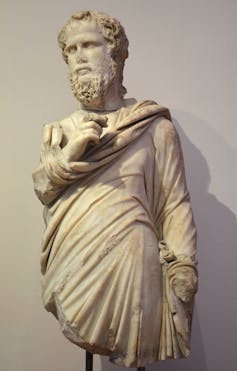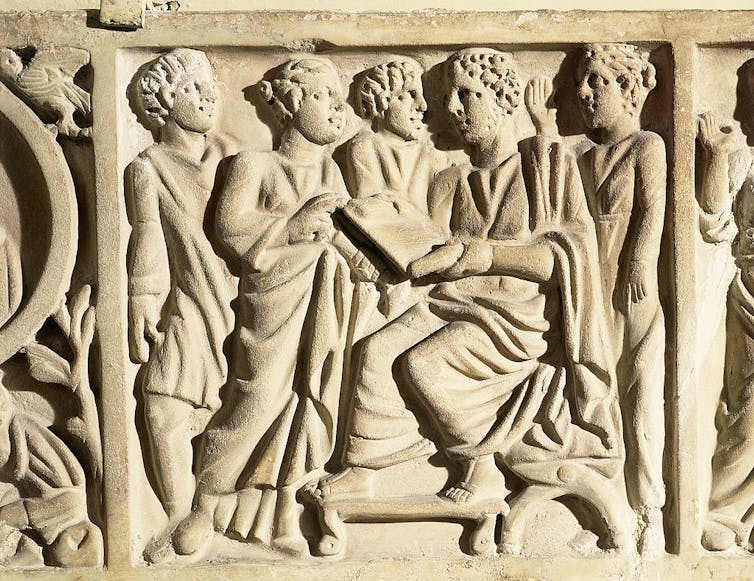
Early on in my writing courses, I ask students to define their sense of rhetoric. Responses range from “persuasion” to “manipulation,” but they tend to share a negative connotation. Little wonder: In America today, the word is often used to dismiss a political opponent. Whereas a Democrat may find a favorite candidate’s speech inspiring, a Republican might call it “mere rhetoric,” implying a lack of substance or even honesty.
But what is rhetoric, really? More importantly, what does rhetoric do?
Today, rhetoric is often associated with one-sided arguments that cater to a particular corner of an echo chamber. Writing something off as “rhetoric” is often a power play, more about putting down an opponent than really seeking truth. Yet the earliest sense of the word, from the first rhetoricians 2,500 years ago, may help us listen to, learn from and even see validity in other perspectives.
The famous triad
Do some digging on rhetoric and you’ll run into Aristotle, who literally wrote the book on rhetoric. The Greek philosopher defined it as an ability to discern what would be persuasive to a particular audience and move them toward some desired opinion or action.
In fact, if my students know anything about rhetoric’s roots, it’s Aristotle’s three rhetorical appeals. Aristotle said that rhetoric could appeal to an audience in three main ways: through emotion, called pathos; through moral arguments or character, called ethos; and through logic or reason, called logos.
But Aristotle didn’t invent rhetoric himself. His teacher Plato probably coined the Greek term, which meant the “art of speaking,” and used it to describe the practices of an even older group of thinkers and orators: the Sophists.
Wandering teachers
The Sophists roamed Greek city-states some 70 years before Aristotle, teaching effective communication skills and sometimes antagonizing people along the way. Protagoras, the first Sophist, was also the first person on record to have his writing burned by a public authority.
Although the Sophists’ teachings’ varied, they were alike in important ways, such as challenging the notion that timeless truth exists. What people can determine, they argued, is what is relatively better or worse.

Both Plato and Aristotle condemned the Sophists, whom they viewed as a threat to objective truth and thus to philosophy itself. Platonists believed they could determine what was objectively right and wrong, good and evil, true and false.
Centuries later, modern scholars have reassessed the Sophists and pieced together fragments of their work. The Sophists’ rhetorical practices acknowledge the diversity of cultural, moral and political values but avoid “anything goes” relativism. I’d argue that these qualities make their ideas particularly relevant for U.S. society today, which is divvied up into ideological echo chambers.
‘Man is the measure’
Protagoras is most remembered by one line: “Man is the measure of all things.” In other words, he claims that human beings are the judges of values and ideas, of what is to be believed and not to be believed.
But in my view, the “man-measure doctrine” does more than say “It’s all relative.” It can prompt people to reflect on what standards, or criteria, we should use to make decisions.
The Sophists’ interest in rhetoric – effective communication – was not abstract. They were teachers and “orators,” arguing cases in Greek city-states’ courts and governments. They were concerned with practical action. Just as one uses a measuring stick as a criterion of length or width, Sophists used one’s sense of value to determine what constitutes a better or worse action.
Protagoras emphasized, however, that not all measures are equal; some are superior to others in any given situation. In a country where democracy is valued, for instance, certain policies objectively strengthen or weaken democratic action. But those same policies may not work well in differently organized countries. There is no one-size-fits-all measure: Values must be repeatedly defined, debated and implemented.
In the modern context, this doctrine may help avoid the “anything goes” dangers of relativism, but also the “my way or the highway” danger of moral certitude. The question for Protagoras is not necessarily “What is true?” but “What is best for the moment?”
Doing 180s
It’s not enough to choose a measure and defend it, though. To have a real conversation, people must discuss, compare and test competing values.
Here, too, the Sophists may be of help. The “Dissoi Logoi” is an anonymous work related to Protagoras’ methods, written around 400 B.C.E., whose title means “contrasting arguments.” This is an exercise in which a rhetoric teacher would ask students to outline one of their firmest convictions, then ask them to defend the opposing view.
This practice tests students to argue a view from all sides – challenging different ideas to arrive at the strongest conclusion. Using dissoi logoi in any setting is valuable for understanding someone else’s positions and commitments, whether one is persuaded or not.

What’s ‘probably’ true
Whereas philosophers of Plato’s time were searching for absolute truth, the Sophists often taught pupils to act on what is probably the case. Enter “eikos,” or probable reasoning.
The Sophist Gorgias, for example, argues from probability in a famous case called the Defense of Palamedes, a mythological figure. According to a common legend, Palamedes had been killed for treason. Gorgias was the first writer to challenge this assumption, illustrating that Palamedes’ guilt was improbable because of a lack of motive and an unlikely chain of events.
Today, almost 2,500 years later, probable reasoning is more significant than ever because of the sheer amount of rapid, often contradictory information that floods the world each day – not to mention methods for manipulating photos, videos, voices and the like. What seems reasonable or true today may be cast into doubt tomorrow.
Moreover, our world is chock-full of mutually exclusive beliefs, from religion to politics. It may not be useful to argue about what is absolutely “true,” but the Sophists help shift our focus to evidence about what “probably” is or is not the case, enabling us to act amid complexity and confusion.
There is one certain fact: There is a diverse but perplexing variety of views on any given issue. Absolute truth may exceed our grasp, but a measure of humility and caution may make it possible to responsibly navigate uncertainty, and the ancient Sophists’ techniques provide ways to do so – but only if people discuss their differences in good faith.
Ryan Leack does not work for, consult, own shares in or receive funding from any company or organization that would benefit from this article, and has disclosed no relevant affiliations beyond their academic appointment.
This article was originally published on The Conversation. Read the original article.







